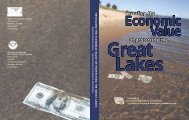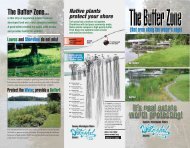Slope Stabilization Work Plan For Poplar River Management Board
Slope Stabilization Work Plan For Poplar River Management Board
Slope Stabilization Work Plan For Poplar River Management Board
Create successful ePaper yourself
Turn your PDF publications into a flip-book with our unique Google optimized e-Paper software.
<strong>Slope</strong> <strong>Stabilization</strong> <strong>Work</strong> <strong>Plan</strong><br />
North American Wetland Engineering, LLC.<br />
January 18, 2007 4444 Centerville Rd, Suite 140<br />
<strong>Poplar</strong> <strong>River</strong> <strong>Management</strong> <strong>Board</strong> White Bear Lake, MN 55127<br />
Phone: 651-255-5050<br />
Fax: 651-255-5060<br />
may be occurring naturally, and what actions will be needed to meet applicable turbidity<br />
standards.<br />
4.4 NRRI Monitoring Station Data Analysis<br />
An analysis of NRRI data from the monitoring stations shows that the turbidity in the <strong>Poplar</strong><br />
<strong>River</strong> varies drastically on a day to day basis. Turbidity data was not available from the<br />
beginning of May until the end of August due to a loss of the monitoring device in the spring of<br />
2006. During these spring and summer months is when the largest precipitation events occurred.<br />
It appears from Figure 4.8 that the turbidity in the river is affected by the flow and stage height<br />
in the river. In the spring, the flow and river stage height are much higher than other times of the<br />
year. Spring runoff and periodic storm events occur this time of year, increasing flow in the<br />
river.<br />
<strong>Poplar</strong> <strong>River</strong>, Lutsen, MN<br />
1400<br />
Flow (ft3/sec)<br />
Turbidity (NTU)<br />
14<br />
Stage Height (ft)<br />
Precipitation (in)<br />
1200<br />
12<br />
1000<br />
10<br />
Flow and Turbidity<br />
800<br />
600<br />
8<br />
6<br />
Stage Height and Precipitation<br />
400<br />
4<br />
200<br />
2<br />
0<br />
0<br />
3/24/2006 5/13/2006 7/2/2006 8/21/2006 10/10/2006 11/29/2006<br />
Figure 4.8: Data from <strong>Poplar</strong> <strong>River</strong> monitoring station<br />
Another factor that can be inferred from Figure 5.8 is the turbidity seems to be affected by<br />
rainfall as well as vegetative cover. In the spring, there is very little leafy vegetation established<br />
until mid-May and the turbidity numbers are consistently high during this period. Also, during<br />
late August and September, there was leaf cover and grasses growing on the megaslump area.<br />
While there are turbidity spikes following rainfall events (where there is data), the spikes have a<br />
longer duration after the beginning of October when the leaves fell from the trees. In October,<br />
31







